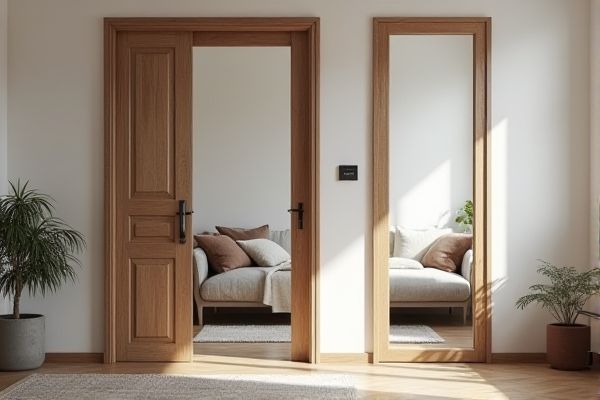
Sliding mirror doors offer a sleek, space-saving design that enhances room brightness by reflecting light, while framed mirror doors provide a classic, sturdy appearance with customizable frame styles for added decor. Discover which option best suits Your space and aesthetic preferences by reading the rest of the article.
Table of Comparison
| Feature | Sliding Mirror Door | Framed Mirror Door |
|---|---|---|
| Design | Modern, sleek with minimal frame | Traditional or contemporary with distinct frame |
| Space Efficiency | Highly space-saving, slides sideways | Requires clearance to open outward |
| Installation | Complex, requires track system | Simple, hinged installation |
| Durability | Moderate, depends on track quality | High, solid frame provides extra support |
| Maintenance | Regular track cleaning needed | Minimal maintenance, frame cleaning only |
| Cost | Generally higher due to mechanism | Typically lower, fewer components |
| Mirror Size | Larger mirror panels possible | Mirror size limited by frame dimensions |
| Customization | Limited frame style options | Wide variety of frame materials and colors |
Introduction to Sliding Mirror Doors and Framed Mirror Doors
Sliding mirror doors offer a sleek, space-saving design with mirrored surfaces that enhance room brightness and create the illusion of more space. Framed mirror doors, featuring decorative borders, provide a classic aesthetic and added durability, often complementing traditional or rustic interior styles. Choosing between these options depends on your space constraints and desired visual impact.
Design Differences: Sliding vs. Framed Mirror Doors
Sliding mirror doors feature a sleek, space-saving design with mirrors mounted on tracks that glide horizontally, making them ideal for modern, minimalist interiors. Framed mirror doors offer a more traditional look with borders that enhance the mirror's structure and style, often adding decorative detail to the room. Your choice depends on the desired aesthetic and space efficiency, with sliding doors maximizing room usage while framed doors emphasize classic elegance.
Space Efficiency: Which Mirror Door Saves More Room?
Sliding mirror doors save more room by gliding along tracks without requiring extra clearance, making them ideal for tight spaces and small rooms. Framed mirror doors often need space to swing open, which can reduce usable floor area and limit furniture placement. Optimizing room layout benefits more from sliding mirror doors due to their compact operation and seamless integration.
Aesthetic Appeal: Modern vs. Traditional Styles
Sliding mirror doors offer a sleek, modern aesthetic that maximizes room space with clean lines and minimalistic design, ideal for contemporary interiors. Framed mirror doors provide a traditional appeal through decorative borders and classic detailing, adding a timeless charm and structure to your space. Choosing between the two depends on whether you prefer the streamlined look of sliding doors or the elegant, defined presence of framed mirrors.
Installation Process: Sliding vs. Framed Options
Sliding mirror doors typically require a track system for smooth operation, making installation slightly more complex but allowing for space-saving functionality ideal for smaller rooms. Framed mirror doors involve securing the mirror within a rigid frame, which simplifies installation and offers added durability, but they need enough clearance for the door to swing open. Your choice depends on the available space and desired ease of installation, with sliding doors providing a modern, streamlined solution and framed doors delivering a classic, sturdy option.
Durability and Maintenance Comparison
Sliding mirror doors typically feature robust aluminum or steel tracks that enhance durability and reduce wear over time, requiring minimal maintenance beyond regular cleaning of the mirror surface and track lubrication. Framed mirror doors, protected by wooden or metal frames, offer added structural strength but may demand periodic upkeep such as frame polishing, paint touch-ups, or rust prevention to maintain appearance and integrity. Choosing between sliding and framed mirror doors depends on balancing the ease of maintenance with the desired longevity and resistance to daily wear.
Cost Analysis: Sliding Mirror Doors vs. Framed Mirror Doors
Sliding mirror doors typically incur higher upfront costs due to complex tracks and hardware, whereas framed mirror doors offer a more budget-friendly option with simpler installation. Maintenance expenses for sliding doors might rise over time because of track cleaning and potential repairs, while framed doors generally require minimal upkeep. Your choice should balance initial investment and long-term durability based on your specific space and usage needs.
Safety Features and Considerations
Sliding mirror doors often feature tempered safety glass designed to shatter into small, less harmful pieces upon impact, reducing injury risk. Framed mirror doors provide added structural support with a sturdy frame that protects the glass edges from chipping and helps contain shards if breakage occurs. Both door types benefit from secure locking mechanisms and smooth track systems to prevent accidental slams and injuries.
Customization and Versatility
Sliding mirror doors offer exceptional customization with options for track styles, panel sizes, and finishes, allowing seamless integration into various room designs. Framed mirror doors provide versatility through choice of frame materials and colors, enabling tailored aesthetics that complement your decor. Both door types enhance space functionality while adapting to your specific style and storage needs.
Choosing the Right Mirror Door for Your Space
Sliding mirror doors save space with their smooth gliding mechanism, making them ideal for compact rooms or closets where floor area is limited. Framed mirror doors offer enhanced durability and design versatility, allowing customization with various frame materials and finishes to match interior styles. Selecting the right mirror door depends on room size, aesthetic preferences, and functional needs, ensuring optimal use of space while complementing your decor.
 homyna.com
homyna.com